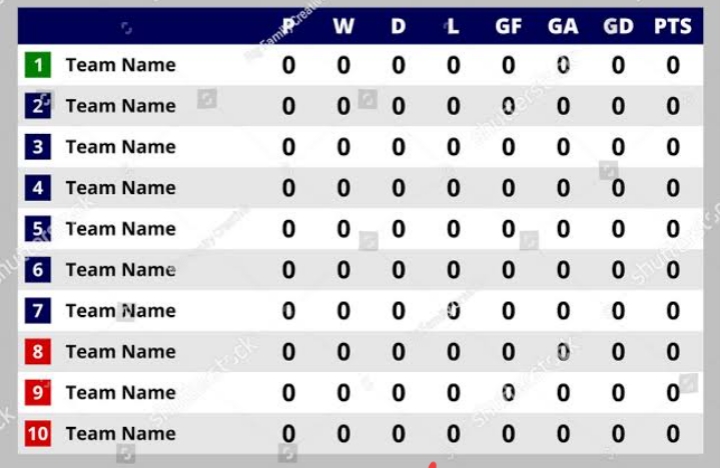As common as soccer standings (also called tables) are, many followers of the round-leather game do not understand the abbreviations and acronyms found on the tables. Plenty of soccer fans cannot understand what abbreviations like MP, W, D, L, GF, GA, GD, and PTS represent on tables.
Standings are used to rank teams in soccer leagues and other tournaments.
Teams playing in a certain league are ranked based on their total number of points and goal differences. Thus, the team at the top of the table has the highest number of points, while the team at the bottom has the lowest number of points.
Teams are awarded points based on the result of each match: 3 points for a win, 1 point for a draw, and 0 for a loss.
Furthermore, the total number of points a team has is according to the number of matches they have won or drawn. The higher number of points they have, the higher the team will be ranked on the standing.
If two teams have the same number of points, they are then ranked based on their goal differences. The team with a superior goal difference is ranked above the other.
Should it happen that the two teams have the same number of points and the same goal difference, the head-to-head performance is used as a determinant. Meaning the team that scored more goals when the two teams played each other (home and away) gets a higher ranking.
Additionally, most soccer leagues feature between 10 to 20 teams. In a 20-team division, each team has to play 38 matches (home and away) before the season ends. Ultimately, the maximum number of points a club can earn in a league season is 114.
In the article, TOP SOCCER BLOG, explains what each abbreviation in a soccer standing stand for.
POS — (Position)
Sometimes denoted by #, this shows the rank (current position) of a team on a table.
MP or PLD — (Match Played)
On every soccer table, MP (Match played) is usually the first abbreviation one will see.
MP stands for matches played in reference to the total number of games a team has played in the competition or league season.
Apart from MP, it can sometimes be written as PLD or just a P.
W — (Win)
W on every soccer standing indicates a win. It is used to represent the number of victories a team has recorded throughout the season or competition.
In addition, the team with the most W (wins) on a table might not actually be ranked first — or emerge as champion — as it might have lost more matches than another team on the table that has instead recorded more draws than losses.
D — (Draw)
The D abbreviation in a soccer standing represents the number of draws accumulated by a team during the season.
Teams who have drawn more games might rank higher than teams that have more wins but more losses.
L — (Loss)
The L symbol is the abbreviation used to represent a loss. Every team’s loss during the season is displayed in this column.
Most times, the team with the most losses sits at the bottom of the standing.
GA — (Goal Against)
GA, meaning Goal Against, indicates the number of goals a team has conceded in the competition or league.
Sometimes it can be written as GC (Goals Conceded) or simply A (Against).
GF — (Goal For)
GF, Goals For — or GS, Goal scored — indicates the number of goals a team has scored during a competition or league.
It is the total number of goals a team has scored against others, and it can be crucial in eventually determining the overall champion — especially when it comes to head-to-head.
In some cases, Goals For (GF) will just be simply written as F, meaning For.
GD — (Goal Difference)
GD, Goal Difference, represents the total number of goals scored by a team minus the goals conceded.
It is one of the most crucial factors in a soccer standing that could decide the eventual champions.
Moreso, it can sometimes be denoted with a plus (+) or minus (—) sign, and in most cases, the combination of both (±).
GAvg — (Goal Average)
Rarely found on most soccer standings, Goal Average (GAvg) is the average number of goals a team has scored throughout the league season or tournament.
It is gotten by dividing the total goals scored (GF) by the goals conceded (GA).
GR, Goal Ratio, is sometimes used in place of Goal Average (GAvg).
PTS — (Points)
PTS is the short form for Points. It indicates the total number of points accrued by a team during and after a competition or tournament.
The word ‘P‘ can also be used in soccer standings to denote points.
Points play a vital role as it is used to determine overall the winner of the league, tournament, or a group.

How do you count points in soccer standings?
In soccer, points are counted to determine a team’s position in the standings.
The points system is quite simple: three points are awarded for a win, one point for a draw, and zero points for a loss.
This means that the more games a team wins, the higher their point total will be, and the higher their position in the standings.
However, it’s also important to keep in mind that if two or more teams have the same number of points, their position in the standings is determined by other factors, like goal difference (the difference between the number of goals scored and the number of goals allowed), goals scored, or head-to-head record.
This adds an extra layer of complexity to the standings, but ultimately ensures that the most deserving teams end up at the top.







